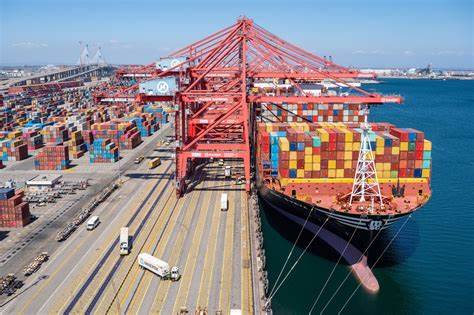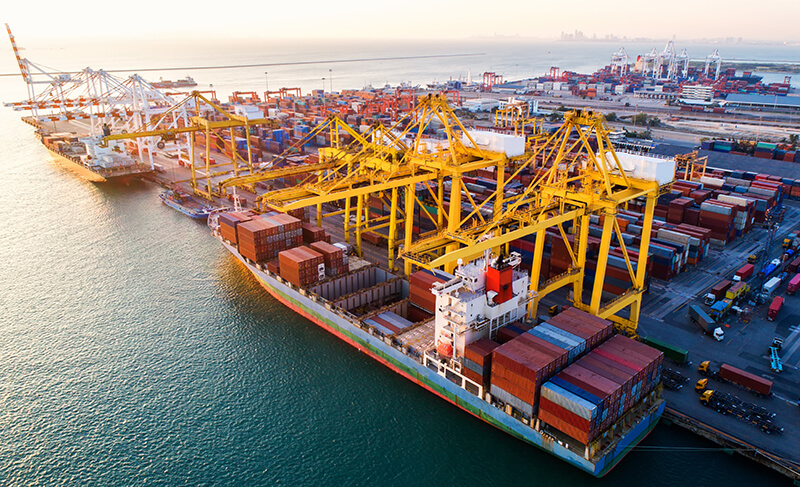Prime Upshots:
- The Biden administration developed a real-time data cooperation with FedEx, Union Pacific, DHL, Walmart, Target, Nike, Home Depot, and other corporations to track the supply chain’s role in inflation.
- The FLOW platform, which was introduced two years ago, is currently growing to track inland freight ports, including end-destination data from warehouses and rail terminals.
- According to Department of Transportation advisor for multimodal freight Andrew Petrisin, “we are getting a look at actual demand,” in a special interview with media outlets.
Since its inception two years ago by the Biden administration, FLOW has collaborated with railroads Union Pacific and BNSF, retailers Home Depot, Nike, Walmart, and Target, and logistics companies CH Robinson, DHL, and FedEx.
According to a recent economic analysis by the White House, the supply chain is responsible for almost 80% of the recent gains made in the U.S. economy’s effort to reduce inflation or disinflation.
“We are getting a look at actual demand,” said Andrew Petrisin, advisor for multimodal freight for the Department of Transportation, in an exclusive interview with CNBC. “By aggregating purchase orders from our shippers 40 days out and importer partners, as well as booking information from our ocean carrier partners 60 days out on a daily basis, the broader membership, can see and understand aggregate future demand.”
Petrisin tells CNBC that the further information will supplement the understanding that large companies get from the platform, which tracks the volume and movement of containers imported into U.S. ports from the export origin and then transported by road or rail to a warehouse or another inland port.
The transfer of empty containers so they can be put onto ships to be filled again by foreign manufacturers, as well as the collection and delivery of loaded containers, are all made possible by the inland ports.

Trailers are moved around at a Walmart Distribution center on May 19, 2022 in St George, Utah. © Provided by CNBC
How Does FLOW operate?
The FLOW platform creates an end-to-end, real-time snapshot of container movements by connecting partners’ various supply chain pipes.
“It’s a collaboration tool,” Petrisin said.
Inbound containerized freight, beginning with importer purchase orders, which serve as a gauge of future demand volumes against the current regional capacity to carry ocean containers, is among the key data that participants gave.
Decision-makers in logistics are using the data to better manage and reduce trade risks, such as the recent closures of the Panama Canal and Red Sea diversions.
Partners that can utilize the data to plan and ensure they have chassis available to load containers onto ships at the West Coast Ports include ocean carriers, according to Petrisin.
“We can get ahead of this and be proactive,” he said.
According to Petrisin, the main objective of the data-sharing platform is to establish a line of sight between the various trade routes and techniques so that users can choose the one that best suits their needs.
Citing an example, “We’re working with an ocean carrier partner to use the purchase order data, to help make a better estimate on future bookings inland,” he added.
Houthi Attacks Fan Supply Chain Concerns In US:
Since the start of the Houthi strikes in the Red Sea last year, the DOT has arranged frequent listening sessions with maritime labour organizations and the freight business.
It is collaborating with FLOW participants to make use of data regarding cargo shifts from the Suez Canal to the African Cape of Good Hope.
To address the current state of affairs in the Red Sea and its implications for shipping and the freedom of navigation, Secretary of Transportation Pete Buttigieg has held meetings with seafarers, ocean carriers, ports, and other prominent figures in the industry.
Deputy Secretary Polly Trottenberg visited the Panama Canal earlier this year, during a drought that has affected global trade by lowering the number of vessels using the canal.
“The Biden-Harris administration’s efforts to strengthen American supply chains have helped reduce inflation from pandemic peaks, and today, with the expansion of FLOW, we expect to see even greater benefits to American families and businesses,” Buttigieg said in a statement.
As part of the Biden administration’s response to four decades of excessive inflation and President Biden’s all-encompassing strategy to address supply chain problems caused by the COVID-19 outbreak, the White House and freight transportation FLOW were established.
From a small initial group of participants, the relationship has grown to include over 70 people, and another 60 are currently in the onboarding process.
Petrisin claims that at certain significant U.S. ports, FLOW is capturing about 80% of the total cargo volume that is booked.
“If the Covid pandemic has taught us anything, it’s that improved communication throughout the supply chain is essential,” stated Jim Bishop, director of marketing and sales at Union Pacific, one of the founding members of FLOW.
According to Paul Brashier, vice president of intermodal and drayage of ITS Logistics, a FLOW partner whose ContainerAI was integrated into the platform, “For the first time we are seeing a strategic executive branch effort to accumulate data and milestones and use that to identify and get ahead of supply chain bottlenecks before they metastasize,”
FLOW is the first instance of a U.S. government office supporting freight transportation, according to Jason Craig, head of government affairs at CH Robinson, one the first businesses to provide its dataset on shipments, routings, and carriers.
“Now there’s an office monitoring for disruptions and dedicated to working with all those other agencies to keep supply chains moving,” Craig confirms. “That’s the main reason C.H. Robinson was one of the first members of the FLOW initiative. … no other entity aggregates real, forward-looking supply chain data across the industry. The pandemic exposed that gap pretty painfully.”
According to Petrisin, real-time comprehension of how demand is affecting capacity, and the supply chain system is crucial to the success of FLOW.
Retailers and logistics organizations may lessen traffic and lower costs by analyzing freight data in real time and seeing the throughput of their shipment.
Petrisin explains, “Everything is interdependent. Like terminal utilization and chassis availability. Providing aggregate statistics and information like this to the industry only complements their existing data and analysis to do better forecasting and service planning.”
Well dear reader, healthy supply chains not only keep the nation finely and evenly stocked and help society grow but also give a big boost to the local economy and industry. These also play a big role in controlling price hikes and in maintaining demand and supply equilibrium.
This is really cool to note how the federal US government monitors the supply of needed stuff to keep the society and industry well saturated and technology plays a critical role.
Please visit us as you look for critical tech news updates in India.







8 Comments
klozet su tesisatı Su tesisat kaçağı Beşiktaş su kaçağı bulma. Beşiktaş su tesisat kaçağı. Beşiktaş su tesisat kaçağı cihazlarla ölçüm su kaçağı bulma su kaçağı tespiti http://bedfordfalls.live/read-blog/51232
Feel free to let me know if you need further assistance or if there’s anything else you’d like to add or modify!
Fantastic beat I would like to apprentice while you amend your web site how could i subscribe for a blog site The account helped me a acceptable deal I had been a little bit acquainted of this your broadcast offered bright clear concept
Hi i think that i saw you visited my web site thus i came to Return the favore Im attempting to find things to enhance my siteI suppose its ok to use a few of your ideas
hiI like your writing so much share we be in contact more approximately your article on AOL I need a specialist in this area to resolve my problem Maybe that is you Looking ahead to see you
You are my breathing in, I possess few blogs and often run out from to post : (.
Hi my loved one I wish to say that this post is amazing nice written and include approximately all vital infos Id like to peer more posts like this
Real Estate This is my first time pay a quick visit at here and i am really happy to read everthing at one place